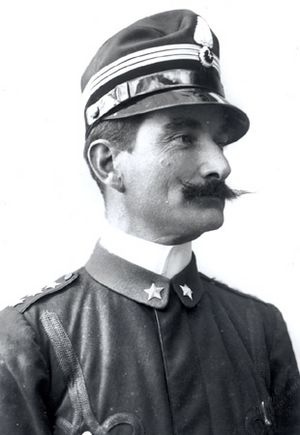Federico Caprilli facts for kids
Captain Federico Caprilli (born April 8, 1868 – died December 6, 1907) was an Italian army officer who rode horses. He completely changed how riders jump over obstacles with their horses. His new way of riding, called the "forward seat," is still the main technique used by all jumping riders today.
Contents
Early Life
Caprilli was born in Livorno, Italy.
The Old Way of Jumping
Before Caprilli, riders used a very different style for jumping. They used long stirrups, pushed their legs far out in front, and leaned way back. As the horse jumped, they would pull on the reins.
People believed this old style was safer for the horse's front legs. They thought the horse's back legs were stronger and could handle the landing better. By leaning back and pulling the horse's head up, riders hoped the horse would land on its back legs first. This was supposed to reduce the impact on the front legs.
However, this old way caused many problems.
- First, it hurt the horse's mouth when the rider pulled the reins over every jump.
- Second, the rider's weight was on the horse's back, pushing them behind the horse's natural movement.
- This weight and the pull on the head made it hard for the horse to round its back over the jump. This natural rounding is called a "bascule."
- Because of this, the rider actually made jumping harder and sometimes painful for the horse. Many horses became unhappy about jumping.
Caprilli's New Technique
Caprilli studied how horses jumped when they were free, without a rider or saddle. He took many photos to see how their bodies moved over fences. He noticed that horses always landed on their front legs first.
Based on this, Caprilli created his new riding style. He wanted a position that would not get in the way of the horse's natural jump. Most importantly, he wanted to avoid touching the horse's mouth during the jump. Caprilli also wanted to train horses to think for themselves. He did not like riders trying to control every tiny step before a jump.
How Caprilli's Style Works
In Caprilli's method:
- The horse was allowed to stretch out its stride. It didn't have to approach the fence in a stiff way.
- The rider sat more forward all the time, even when just riding on flat ground. This matched the horse's more stretched-out body.
- Stirrups were shortened. This allowed the rider to easily lift their seat slightly above the saddle. The rider's thighs and lower legs gave them support.
- Over the jump, the rider kept their seat out of the saddle and leaned slightly forward. They let their hands move forward with the horse's mouth.
- The rider's weight was directly over the horse's center of gravity. This made jumping as easy as possible for the horse.
- When landing, the rider stayed slightly forward, instead of leaning back like in the old style.
- This position was used for all types of obstacles, including banks (up and down) and ditches.
Impact of Caprilli's Method
Caprilli's new way of riding made horses much more willing to jump. They were now free from the rider's interference.
At first, some people in the Italian army didn't like his new ideas. But soon, important leaders in the cavalry saw how brilliant Caprilli's methods were. They invited him to be the main instructor at the Cavalry School of Pinerolo and its branch in Tor di Quinto.
After just one year of training, the students and horses at these schools showed huge improvement. The horses became so willing that riders could complete the training course without even using reins!
Because of these amazing results, the Italian cavalry started winning many international competitions. Riders from all over the world came to Italy to learn Caprilli's system. His style spread globally, especially after he showed it at the 1906 Olympic Games.
Captain Caprilli died in Turin, Italy in 1907. He lost consciousness while riding a horse he was testing, fell, and hit his head.
See also
 In Spanish: Federico Caprilli para niños
In Spanish: Federico Caprilli para niños




